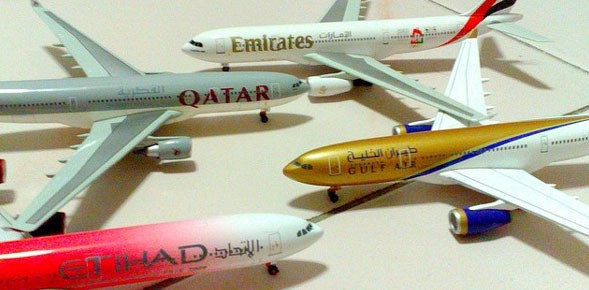Middle-East airlines growth into Southeast Asia goes unabated with more capacities being added into the market. With the opening of secondary routes, they increasingly threaten hub operations of established carriers such as Singapore Airlines, Malaysia Airlines and Thai Airways International.
BANGKOK- Etihad Airways’ arrival in Vietnam and Qatar Airways’ return to Yangon confirm the irresistible growth of Gulf carriers into one of the most dynamic part of the world, Southeast Asia. Most of these carriers started flying into Southeast Asia in the mid-nineties, Bangkok being the first destination served in the region, generally followed by Singapore –due to its financial hub status- and Manila due mostly to large groups of Filipino workers employed in the Middle-East. Gulf carriers already forced local airlines such as Philippine Airlines, Malaysia Airlines and Thai Airways International to reduce their presence in the Gulf –even to close down their operations such as Malaysia Airlines in Dubai.
But the latest round of expansion is now submerging secondary destinations with governments in Southeast Asia unlikely to resist for too long due to the economic pressure that some States such as Qatar or the UAE will put on their Asian counterparts to secure traffic rights for their airlines. A dozen of airlines –if including both Egypt Air and Turkish Airlines which compete on the same segment- serve today nine destinations in Southeast Asia – ten from October with Qatar Airways landing again in Yangon.
What will be the future in the region? As large hubs are already well covered by Middle-East carriers, secondary destinations are the key to the future. Three years ago, Qatar Airways already indicated to pay a close look to Surabaya in Indonesia, a city of over three million inhabitants and a major economic centre; increasing number of tourists going to Phuket and Bali as well as a growing community of expatriates in both resort Islands- are likely to push more airlines asking for traffic rights. Phuket and Bali are for now only served by Qatar Airways, the first one via Kuala Lumpur, the second via Singapore.
Qatar Airways has been so far the most aggressive in the region in terms of destinations. It was the first airline to serve in the early 2000s Yangon as well as Cebu. While Yangon is back on Qatar Airways’ map, Cebu is also likely to be back within the next five years. And this is only a question of time before Emirates or Etihad set their eyes on Yangon as well. Other cities in Southeast Asia with a potential for a direct link to the Gulf are Penang in Malaysia, Medan and Yogyakarta in Indonesia and in a more distant future, Southern Thailand’s province of Krabi due to increasing congestion of Phuket International Airport.
Next October, Bangkok Suvarnabhumi International Airport will still offer the biggest capacity to the Middle-East with 181,567 seats per month followed by Kuala Lumpur with 121,177 and Jakarta with a total of 82,238 seats per month. Emirates Airlines meanwhile remains the largest carrier to the region in seat capacities. The carrier offers up to four daily flights to some capitals in the region, being the first to put into service the Airbus A380. It is followed by Qatar Airways with the largest portfolio of destinations.
Table: Middle East Airlines seat capacities out of selected destinations in Southeast Asia to the Middle East for October 2012

(Source: IATA-SRS Analyzer-July 2012)
Luc Citrinot a French national is a freelance journalist and consultant in tourism and air transport with over 20 years experience. Based in Paris and Bangkok, he works for various travel and air transport trade publications in Europe and Asia.













































































